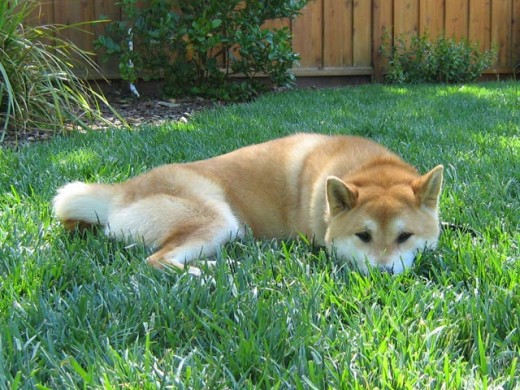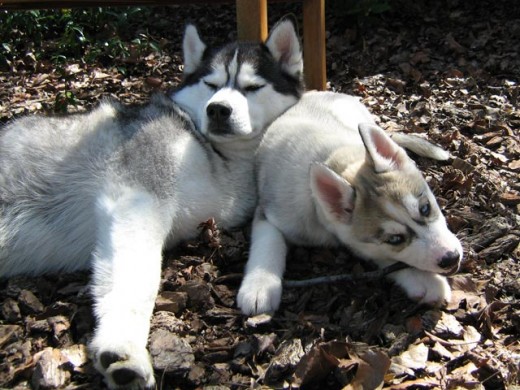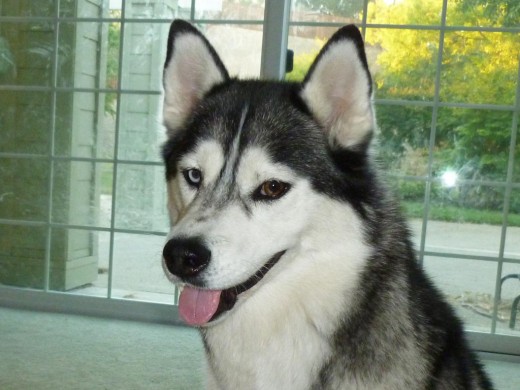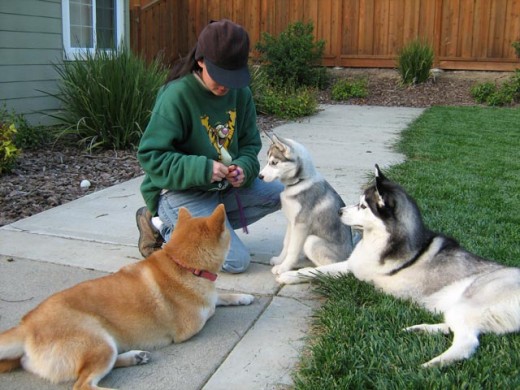Like us, dogs have anxieties and fears. A dog’s anxieties, may not be the same as our own anxieties, but they cause stress and physical reactions just the same.
Some common dog anxiety problems include –
- Separation anxiety – A dog gets anxious when left alone.
- Noise anxiety – A dog becomes fearful when exposed to loud or unusual noises. Some examples include fireworks, thunderstorms, garbage trucks, and more.
- Travel anxiety – The car is like a den, but dogs are unaccustomed to moving dens. Therefore, they may become unsure and stressed over something so new and unexpected.
- Confinement anxiety – A dog gets anxious when he feels trapped or confined. If a threat should arise, a confined dog may be unable to escape or flee.

Symptoms of Dog Anxiety

When dogs are anxious, they may engage in repetitive or displacement behaviors to relieve their stress. For example, when we are anxious, we may pace, bite our nails, or play with our hair.
Dogs may also pace, groom, and more. Some dog anxiety behaviors may lead to property destruction, may cause us harm, or may simply be undesirable to our human sensibilities. This may include –
- Non-stop barking.
- Chewing up furniture, walls, shoes, garbage, and anything else in sight.
- Pooping and peeing in the house, crate, or other confinement area.
- Eating his own poop.
- Aggression toward people, dogs, or other animals.
Punishment or aversive techniques will do little to stop these anxious dog behaviors in the long-run, because punishment does not address the source of the problem, which is the dog’s anxiety. In fact, suppression of these displacement behaviors, through pain and dominance methods, will make the problem worse, because pain increases stress and uncertainty.
Below are some common ways on how to deal with dog anxiety.

1. Desensitization Exercises

One of the best ways to help a dog deal with his anxiety issues, is by slowly desensitizing him to the problem stimulus.
In the desensitization process, we start with a weak version of the stimulus that is triggering the anxiety attack.
The stimulus must be weak enough, so that my dog is able to stay calm in its presence. Then, I get him to focus on me, by doing eye-contact commands or simple obedience exercises.
If my dog is able to focus and stay in-control, I reward him with a very high priority treat. For desensitization purposes, I usually bust out the really good stuff. I try to pick a highly aromatic or smelly treat that my dog loves, but does not usually get to eat. The smell will help to engage his nose, and further distract him from the source of his anxiety.
When he is comfortable with this exercise, is calm, and able to follow simple commands, I very slowly raise the strength of the problem stimulus. I make each session short, fun, and very rewarding.
In this way, my dog learns alternative behaviors for dealing with stressful situations. He also learns to associate something that was previously a source of fear and stress, with something positive (nice smells, yummy treats), and with being calm.

2. Calm Environment

Another important aspect of helping an anxious dog, is to create a calm and predictable environment for him, in his daily life.
- Fixed routine – I set a fixed schedule for feeding, walking, play-time, leaving the house, coming home, and more. I also establish a fixed set of rules, and a consistent way of enforcing them. A very fixed routine and rule-set, helps our dog understand what to expect from us, and also what we expect from him in return. Greater certainty reduces anxiety and stress.
- Staying calm – Most dogs are very good at picking up the energy of the people around them. My Shiba Inu, for example, is very sensitive to what I am feeling. If I get stressed and anxious, he picks up on that immediately and becomes anxious himself; but with a hundred times more gusto! Therefore, it is important for us to stay calm and in-control.
- Relaxing massage – Some trainers suggest giving our dog a massage to help him relax. There is also the special TTouch massage method, which uses circular finger motions to help relax our dog’s body.
I tried the TTouch method briefly on my Shiba Inu, but it did not seem to have much of an effect on him. Desensitization exercises, together with a fixed routine and consistent rules, helped us most.

3. Calming Equipment
There are a variety of products designed to help calm our dogs. The attraction of such products, is that they require little to no work from us. However, it is also unclear how effective they truly are.
a) Dog Appeasing Pheromone (DAP)
DAP is a synthetic chemical that was developed based on a hormone produced by nursing mother dogs. Mother dogs produce this hormone to help their puppies feel calm and secure. It also helps the mother dog establish a positive bond with her puppies.
Scientific studies *do* show that DAP has a positive effect on puppies. However, it is unclear whether DAP helps with anxiety problems in adult dogs.
There are also a variety of natural calming scents, including lavender, and other herbal remedies.

b) Dog Calming Music
“Music has charms to soothe a savage breast, To soften rocks, or bend a knotted oak.”
~~[William_Congreve]
Music can certainly help calm us down and soothe our nerves. Therefore, it is not such a big stretch to imagine that it can also be helpful to our dogs. However, the wrong kind of music can actually increase anxiety in dogs.
What is the right kind of dog music?
According to sound researcher Joshua Leeds,
“Rock music, jazz, heavy metal made them more anxious. Classical slowed them down. It just relaxed them in a way that the other music seemed to irritate them.”
~~[Want to Calm Fido Down? Try Music!]
The Thundershirt looks like a dog winter coat. It wraps around the torso of a dog, and works by exerting constant pressure on the dog’s body. Proponents argue that this pressure, can have a calming effect on the dog’s nervous system.
However, the only study I found was a very limited experiment, from an unsubstantiated source. Therefore, it is unclear whether the claims made on the effectiveness of Thundershirts are true.
Note – Pressure wraps will not work on all dogs. Some dogs may get even more anxious, when they experience continuous pressure on their body. In addition, it is unlikely that pressure wraps can fully solve our dog’s anxiety issues. Wraps and other calming equipment, are commonly used together with desensitization and other dog behavior modification techniques, to achieve true long-term success.
Depending on the dog and the situation, you may need to incorporate training with the cape to show an effect. The Anxiety Wrap recommends an 11-step treatment program for separation anxiety that includes using the wrap and leaving toys filled with favorite food treats for the dog to enjoy while you are gone.
Some people also use clocks or heartbeat pillows, to help calm new puppies.

4. Medication
Do not medicate your dog with over-the-counter human drugs, on your own. Dogs have very different physiology than humans, and dosage is very dependent on weight.
I always consult with my vet before giving my dog any medication.
Some medications used to suppress a dog’s anxiety response include –
- Clomipramine(Anafranil) – This drug was originally developed to treat OCD in humans. With dogs, it is sometimes prescribed to treat OCD and separation anxiety issues.
- Fluoxetine(Prozac,Sarafem,Fontex) – Fluoxetine is perhaps most well-known by its tradename Prozac. Prozac is used to treat heavy depression, OCD, and serious eating disorders (Bulimia nervosa) in humans. Eli Lily makes a special Prozac for dogs called Reconcile.
For lonely dogs with separation anxiety, Eli Lilly brought to market its own drug Reconcile last year. The only difference between it and Prozac is that Reconcile is chewable and tastes like beef.
- Sedatives – Powerful sedatives such as benzodiazepine (benzo) are prescription only. Some lighter sedatives such as antihistamines (Benadryl) and valerian can be obtained as over-the-counter medications for humans. Do not give sedatives or any other medication to dogs, without first consulting with a veterinarian.
The dog medication business is now a very profitable enterprise, and there are a large number of dog drugs available for purchase. These medications treat anything from separation anxiety, OCD, and depression, to motion-sickness, forgetfulness, and obesity. Most dog medications are short term solutions and may have serious side effects.

Dog Anxiety Problems
I believe that the best way to help our dogs with their anxiety issues, is through desensitization, as well as a calm and relaxed home environment.
Dog calming equipment and medication are very tempting solutions, because they involve little to no effort from us. However, their long-term effectiveness is highly questionable. These methods work by suppressing or muting the effects of anxiety, rather than addressing the source of the anxiety itself.
This is in contrast with desensitization and home management techniques, which target the anxiety stimulus, and teaches the dog new ways to cope with fear and stress. Rather than just suppressing symptoms, desensitization helps to build a dog’s confidence, and promotes a stronger bond between him and his human companions.
Ultimately, behavior modification and desensitization techniques lead to long-lasting effects, and a better quality of life for a dog and his family.


I have a Brussels Griffon and he has the same symptoms as I read in your post. I have no idea how to help him,when I leave he goes crazy barking and trying to get out and then when I come home is is sweating so bad…..we hate to invite friends over because you would think he’s going to rip their leg off but he wouldn’t bit anyone. So I was hoping for some advise from you that might help my Brady
With my dog, I do desensitization exercises to help him with his separation anxiety-
http://shibashake.com/dog/separation-anxiety-dog-why-how-reduce-dog-stress#desensitize
Dog behavior is very context dependent though, so getting help from a qualified professional trainer can also be helpful.
http://www.apdt.com/pet-owners/choosing-a-trainer/
i have a 4 year old dachshound. i think she has anxiety. if she’s in my room with the door is closed.she does this scratching at the carpet. and tries to dig a hole into the floor. and she’s doing this whinning thing too. i live with my mother and she has 2 cats. sometimes they play, but at night time she sneaks out of the room to rip open a trash bag and starts fights with the cats. and i don’t usually have a ride to take her to the vets. is there anything i can do. before i go completely nuts with her.
Here is more on separation anxiety and what I do to help my dog-
http://shibashake.com/dog/separation-anxiety-dog-why-how-reduce-dog-stress
At night, my Shiba Inu sleeps in a crate in the bedroom with me. I make sure to exercise him well every day so that he has a way to relieve stress & explore, as well as positive outlets for his energy. I also use baby gates as necessary, and in the kitchen, I use a closed trash can, that is in a closed area that he cannot get to.
I also set up a fixed routine for my dogs, and a consistent set of house rules. I motivate them to follow house rules by following the Nothing in Life is Free program. A fixed routine and consistent rules helps to reduce uncertainty, and that helps to reduce stress and anxiety.
Here is a bit more on how dogs learn. Getting help from a professional trainer can also be helpful.
http://www.apdt.com/pet-owners/choosing-a-trainer/
I have a problem with my 6 month german shepard.She is afraid to go out for a walk that I will have to drag her out and then she will be fine.Then all a sudden it looks like she realise that she is outdoors and the story begins!!!She will start pulling on the leash her tail tucked between her legs and she will not respond to any command or treat not even her favourites.The only thing she will want is getting back home and then she will be fine!!What do you think is the problem and hpw should I tackle it?THANK YOU.
When my Husky puppy was young, she would sometimes get anxious about new things or loud sounds. For example, Shania was afraid of the garbage truck, and Lara would get anxious about people who are on bicycles or skateboards.
When I start to leash train my Husky puppy, I first do it in a safe environment, e.g. inside the house. In this way, she can slowly get used to the collar, the feel and weight of the leash, and me holding the leash. I make sure to desensitize her to the collar and leash, and I make sure that our leash training sessions are positive and very rewarding – with fun games, movement, and her favorite treats.
When my puppy is comfortable with leash training inside the house, then we do leash training exercises in the backyard. It is quiet in the backyard and low stimulus, so it is a good transition step.
After we have conquered the backyard, I take her on short but more frequent walks that are close to home. I live in a quiet neighborhood, so it works out well. I make sure to always stay calm and to always make our outings positive. I play Find-It and other games with my puppy so that she gets engaged with me, and learns to associate walks with rewards and fun.
Once she is comfortable with that, I very slowly increase the environmental challenge. I also do additional desensitization exercises for loud scary sounds (e.g. garbage truck) or other things that are especially scary to her.
In general, I try to set my puppy up for success by controlling the environment so that she can handle it, without getting overcome by fear. We always start small, and go in very small steps. The more successful walks we have, the more confident she becomes, and the next day, we can do a bit more.
Question— We have a 10 year old yellow lab. He has spent most of his life as an outside kennel dog with a nice warm house. In the winter he will be kept in the heated garage and on occasion come in the house. Then in the spring he will move back out. This past year he started crying by the front door and one night got very upset and started chewing on the front door wanting to come in. Now in the nice weather he no longer wants to be out in the kennel very long, ESP near evening. He will chew through the wire to get out. What is going on with him?
Did something out of the ordinary happen when his behavior changed? Did his routine change, or did the family routine change? Previously, has he always been calm while alone in his kennel? What is his routine like?
It could also be a physical health issue – older dogs may need to do business more often, or may have joint pain. Has he been to the vet recently? How is his health?
someone can you please help i have a 4 yr old German Shepard pitbull mix that is terrifed of people.mostly men.but he wont go on walks and always stays inside.he needs to exercise.we cant take him anywhere.i feel horible cause he wants to go but once he is outside he gets scared and runs to the house.
Hmmm, when did this behavior start? How long has it been going on? Does he do well with men who are part of the family?
For anxiety and fear issues, desensitization and counter conditioning techniques have worked well for my dogs.
http://shibashake.com/dog/how-to-calm-a-fearful-reactive-dog#people
It also helped for me to visit with some professional trainers. They were able to observe my Shiba Inu, read his body language, and identify the exact triggers that caused him stress. We were then able to come up with a good plan to desensitize him to those triggers, and teach him alternate behaviors for dealing with his stress.
Very thorough and well written hub. I would like to direct you to the Anxiety Wrap. It is the original patented pressure wrap designed for dogs – and cats – by Susan Sharpe, a T-touch practitioner and certified professional dog trainer. I believe the Anxiety Wrap is a superior product and recommend it in my own practice with clients who consult me about their anxious and fearful dogs. In a recent study completed at Tufts University School of Veterinary Medicine, the Anxiety Wrap was found to be 89% effective in study participants – dogs with Thunderstorm phobia. I have used it on dogs with separation anxiety and generalized anxiety, including my own dog and have found it to provide consistently effective results. Check it out – I think you’ll be quite impressed too, and thanks for writing such a detailed, well thought out hub!
Great stuff. I am really impressed by your writing and the topic you choose regarding dog anxiety problems. Thanks a lot for sharing.
Your hub is so informative. We had a dog for 17 years, 13 of which were filled with major separation & noise anxiety. It’s a tough situation to deal with because she would do anything she could to get out of the house/yard if we left her including digging, jumping fences, etc… Everything we tried, including bringing her with us, didn’t work because she would be so stressed. The only thing we found to help her was an herbal remedy called Aconitum Napellus. We bought it at Whole Foods and it made a significant difference. She’s in heaven now after a long life but the thunder jacket you wrote about looks like something we would have tried.
Hi we have a Westie and he loves going to the park but is scared of traffic noise,also any noise I make in the kitchen
Yeah, my Husky Shania was very afraid of garbage trucks when she was young. Doing desensitization exercises helped her gain confidence and become less fearful.
i love your dog hubs,,, and i love the “eye makeup” for the young siberian,, we had a female sibe (who lost her makeup after a year) and she was so loving to everyone except neighbors pet rabbits and our pupplies. she ran away so often (even over 7 foot fences) that we had to build a kennel..also, she ripped up our young female newfie until the newfie got big enough and took her down,, she was a great dog tho
Very useful hub. If people followed these tips many would not end up in shelters. Beautiful dog pics too!